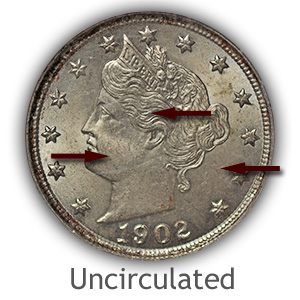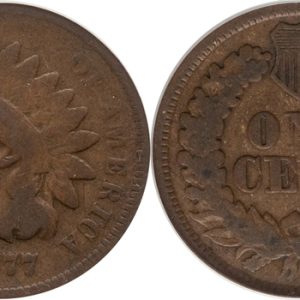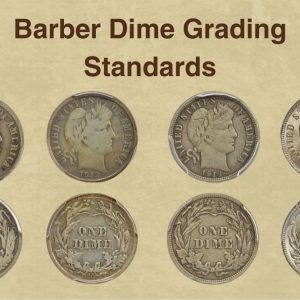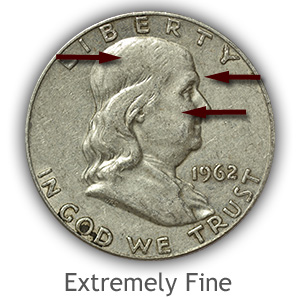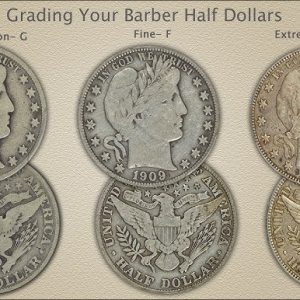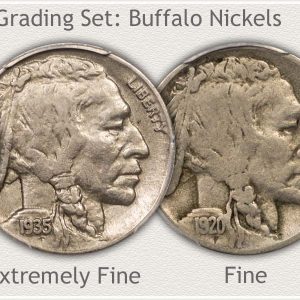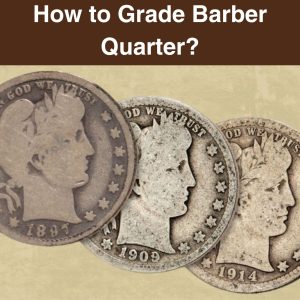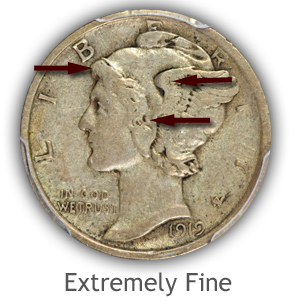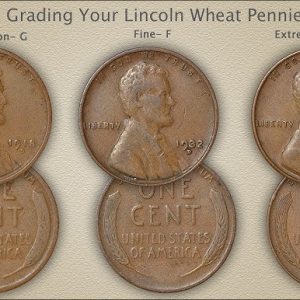To grade a Walking Liberty Half Dollar, examine wear on high-point details including Liberty’s breast, arm, and dress folds on the obverse, plus the eagle’s breast, head, and wing feathers on the reverse. Assess the original mint luster—uncirculated coins display unbroken brilliance radiating from the center, while any dullness indicates wear. Check for contact marks, hairlines, and weak strikes that can lower the grade. Professional grading uses a 70-point scale, with MS-65+ considered gem quality. Use a 5-10x magnifier for accurate inspection and compare with graded examples for best results.
Grading a Walking Liberty Half Dollar accurately can mean the difference between a $20 coin and a $2,000 treasure. These iconic silver coins, minted from 1916 to 1947, feature Adolph Weinman’s stunning Liberty design that shows wear in predictable patterns. Whether you’re building a collection or evaluating an inheritance, understanding how to assess these high points, original luster, and circulation wear will help you determine true value without relying solely on expensive professional services.
Understanding the Critical High Points on Liberty’s Figure
The obverse high points reveal wear faster than any other area on Walking Liberty halves. Liberty’s left breast shows the first signs of circulation, appearing as a flattened area where the natural curve should exist. On a mint state coin, this area retains full, rounded detail with unbroken luster radiating outward. Even brief pocket change exposure creates a small flat spot here.
Her extended left arm represents the second critical examination point. Uncirculated examples display complete muscle definition from shoulder to hand, with the fabric folds showing sharp separation. Once this coin enters circulation, the highest point of the arm loses its dimensional quality first. A genuine MS-60 coin maintains all arm contours, while an AU-58 specimen shows slight flattening despite appearing uncirculated to casual observers.
The skirt folds across Liberty’s legs require careful inspection under proper lighting. On coins grading Fine (F-12) or below, these lines become shallow or merge together. Very Fine (VF-20) examples retain most major fold lines but lose the finer details between them. Extremely Fine (EF-40) specimens preserve nearly all fold definition except on the highest fabric ridges touching Liberty’s forward leg.
Liberty’s sandal straps provide an excellent grading checkpoint for lower-grade coins. These delicate details completely disappear on Good (G-4) examples, begin emerging on Very Good (VG-8) coins, and show full separation by Fine (F-12). Collectors examining potential VF or EF purchases should see complete strap definition with only minor wear on the highest leather points.
Evaluating the Eagle’s Distinctive Features
The reverse eagle presents equally important grading indicators starting with the breast feathers. Mint state Walking Liberty halves display fully separated breast feathers with distinct quill lines within each feather. This area sits highest on the reverse design, making it vulnerable to immediate wear. AU-50 coins show slight merging of the central breast feathers while maintaining sharp outer feather definition.
The eagle’s left wing edge (right side when viewing the coin) serves as the primary reverse wear indicator. On MS-65 or higher specimens, every feather along this wing edge stands in crisp relief with visible separation between each plume. Circulation wear first appears here as a slight flattening of the topmost feathers. By AU-58, subtle wear becomes visible under magnification, though full feather outlines remain.
Leg feathers present a grading challenge because many Walking Liberty halves suffered weak strikes during production. The Philadelphia and San Francisco mints produced sharper strikes than Denver between 1941-1945. A weakly struck MS-63 coin might show less leg detail than a sharply struck EF-45 specimen. Experienced graders tilt the coin under direct light, watching for luster breaks that indicate true wear versus incomplete metal flow during minting.
The pine branch held in the eagle’s talons loses definition progressively through circulation grades. Uncirculated examples show individual needles clustered along each branch. EF-40 coins retain the branch outline with some needle detail visible. VF-20 specimens display the branch as a textured bar without individual needle separation. This progression provides reliable confirmation when other grading points seem ambiguous.
Assessing Original Mint Luster Patterns
Mint luster represents the most definitive separator between uncirculated and circulated grades. Freshly minted Walking Liberty halves exhibit a satiny, flowing luster that creates a “cartwheel” effect when rotated under a single light source. This effect appears as bands of light rolling across the coin’s surface perpendicular to rotation. MS-65 and higher specimens maintain this full cartwheel across all surfaces including the fields.
Lower mint state grades from MS-60 to MS-64 retain complete luster but show varying degrees of contact marks and bagmarks from striking and storage. An MS-60 coin displays numerous contact marks in the open fields around Liberty and the eagle, yet the luster remains unbroken by wear. These marks occurred at the mint or during original bag storage, not from circulation. The luster flows continuously over these marks without interruption.
About Uncirculated (AU) grades from AU-50 to AU-58 represent the challenging transition zone. AU-58 coins retain perhaps 90% of original luster with only the highest points showing slight dulling. Under magnification with raking light, small luster breaks appear on Liberty’s breast and arm, plus the eagle’s breast and wing edge. These breaks appear as matte or dull patches interrupting the reflective surface flow.
AU-50 specimens show obvious luster loss across all high points while retaining perhaps 50% luster in protected areas. The fields around Liberty’s legs and behind the eagle often preserve original mint surface. This partial luster distinguishes AU grades from Extremely Fine (EF-45 and EF-40) where luster essentially disappears except in the most protected letter recesses.
Circulated grades below EF-40 lack mint luster entirely, instead showing the dull gray or worn silver surface of pocket change. Some Very Fine examples retain trace luster deep within protected areas like between skirt folds or under the wing. This residual luster helps separate VF-30 from VF-20 grades when other characteristics appear borderline.
Identifying Common Strike Weaknesses and Authenticity
Strike weakness plagued Walking Liberty production throughout the series, particularly affecting Denver Mint coins from 1941-1947. The design’s high relief challenged minting equipment, resulting in incomplete detail transfer even on uncirculated specimens. Collectors must distinguish weak strikes from genuine wear to avoid undergrading mint state coins or overgrading circulated examples.
The eagle’s left leg and talon frequently show weakness regardless of grade. Examining a suspected weak strike requires checking luster presence on the apparently weak area. If full cartwheel luster flows across weak leg details, the coin suffered incomplete striking rather than wear. If the weak area shows dullness or luster breaks, genuine circulation caused the flatness. Comparing multiple examples from the same year and mint reveals normal strike characteristics.
Liberty’s head presents another common weak area, particularly on 1923-S, 1938-D, and 1946-D issues. Some dates show Liberty’s facial features softly defined even on certified MS-65 examples. The Numismatic Guaranty Corporation (NGC) and Professional Coin Grading Service (PCGS) consider normal strike weakness when assigning grades, not penalizing coins for typical production characteristics.
Die clashing creates raised design elements in fields from dies striking together without a planchet between them. These clash marks appear as faint ghosted images—Liberty’s profile in the reverse field or eagle details on the obverse. Clash marks don’t affect grade unless they significantly distract from eye appeal. Strong clashes might drop a borderline MS-66 to MS-65 but won’t change AU to EF grades.
Counterfeit detection requires attention beyond wear and luster. Authentic Walking Liberty halves weigh 12.5 grams with 90% silver content. The distinctive ring of genuine silver sounds when tapped—counterfeits produce dull thuds. Mint mark positions remain consistent: Denver’s “D” and San Francisco’s “S” appear on the reverse below the pine branch just left of center. Philadelphia issues carry no mint mark through 1967.
Determining Value Based on Accurate Grades
Grade accuracy directly impacts market value across all Walking Liberty dates. Common dates like 1943 and 1944 in EF-40 condition trade around $12-15, while the same dates in MS-65 command $85-110. This seven-fold price difference makes grading precision financially important. Rare dates show even more dramatic spreads—a 1921-D grades VF-20 sells near $150, while MS-63 examples approach $8,500.
| Grade | 1943 P/D/S | 1921-D | 1938-D |
|---|---|---|---|
| G-4 | $11 | $65 | $13 |
| VF-20 | $14 | $150 | $16 |
| EF-40 | $18 | $425 | $22 |
| AU-50 | $28 | $1,200 | $38 |
| MS-60 | $45 | $2,800 | $65 |
| MS-63 | $68 | $5,200 | $145 |
| MS-65 | $95 | $18,500 | $425 |
Professional grading services charge $20-40 per coin for standard service, with higher fees for expedited grading or high-value submissions. This investment makes sense for coins potentially grading MS-64 or higher, rare dates, or specimens where one grade difference means hundreds of dollars. A 1921 Philadelphia half dollar grading MS-64 sells around $2,400, while MS-65 examples bring $6,500—easily justifying the $35 grading fee.
Self-grading serves collectors building type sets or accumulating common dates where small grade variations matter less. Someone assembling a circulated set from Good through Extremely Fine can reliably differentiate these grades with practice and reference materials. The American Numismatic Association’s grading guide provides detailed photographs showing exact wear patterns for each grade level.
Market-graded coins sold as “uncirculated” or “AU” without third-party certification carry risk. Sellers often overgrade by one or two levels, either from inexperience or profit motive. A coin described as MS-63 might actually grade AU-58 or MS-60, significantly affecting value. When purchasing raw (ungraded) coins above $100, either develop strong grading skills or insist on return privileges pending your own examination.
Building Grading Expertise Through Comparison
Successful grading requires studying many examples across different grade levels. Local coin shows provide opportunities to examine dealer inventory, comparing certified coins with assigned grades. Most dealers welcome serious questions about grading, especially from collectors genuinely trying to learn. Handling an MS-65 alongside an AU-58 reveals subtle luster differences that photographs cannot capture.
Online auction archives from Heritage Auctions and Stack’s Bowers contain thousands of graded Walking Liberty images with detailed descriptions. Searching for specific dates like “1941 Walking Liberty MS-64” returns multiple examples showing that grade’s characteristics. Comparing ten different MS-64 coins reveals the range of contact marks, toning, and luster quality acceptable within that grade.
Joining the American Numismatic Association provides access to their correspondence course on coin grading. This home-study program includes actual coins representing different grades, with expert feedback on your assessments. The $60 course fee includes ANA membership, their magazine, and access to their extensive numismatic library.
Practice grading begins with coins you already own or inexpensive common dates. Examine a coin thoroughly, record your grade assessment with supporting observations, then research actual market sales of that date and grade. Over time, your estimates will align more closely with professional opinions. Track your accuracy rate—successful self-graders achieve 85-90% agreement within one grade point of professional services.
Maximizing Your Collection’s Potential
Understanding how to grade Walking Liberty Half Dollars transforms you from passive accumulator to informed collector. Each coin represents a specific moment in American minting history, with its current condition telling the story of its journey. Whether you’re evaluating a single inherited coin or building a complete date set, accurate grading ensures you pay fair prices and recognize genuine opportunities. Start with common dates to build your skills, use magnification and proper lighting, and don’t hesitate to seek professional opinions on valuable pieces. The expertise you develop will serve every future numismatic decision you make.
You may be interested:
- How To Grade Peace Silver Dollar Using The Sheldon Scale And Key Wear Areas
- How To Grade Roosevelt Dime Check Wear Strike Quality And Full Bands For Accurate Coin Values
- How To Grade Washington Quarter Coins By Examining Wear On High Points And Mint Luster
- How To Grade Morgan Silver Dollar A Complete Visual Guide To Assessing Coin Condition And Value
- How To Grade Lincoln Wheat Penny Check These 4 Key Features For Accurate Coin Value Assessment
- How To Grade Jefferson Nickel Check These Key Areas And Full Steps For Maximum Value
- How To Grade Mercury Dimes Check High Points And Full Bands For Accurate Valuation
- How To Grade Barber Quarter Coins By Checking Libertys Headband And Eagle Feathers

